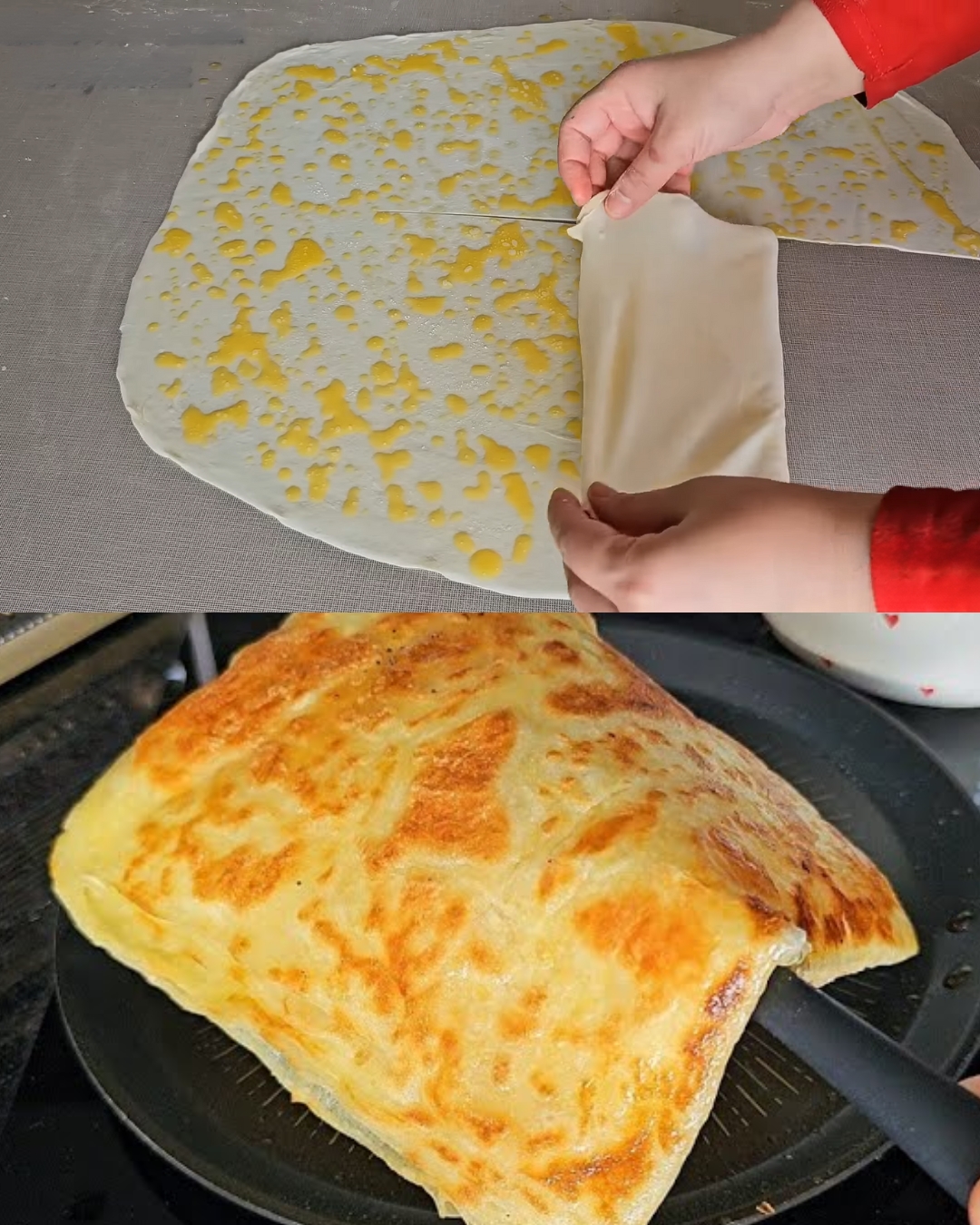Crispy on the outside, soft and stringy on the inside—this Layered Turkish Pan Bread is a rustic and irresistible flatbread that comes together with just a few pantry staples. Known for its beautiful folds, buttery layers, and toasty finish, this traditional bread is a popular staple across many Turkish households. Whether served at breakfast, with soups, or alongside grilled meats, it’s a versatile favorite that captures the magic of homemade bread in the simplest way possible.
In this recipe, a basic flour-and-water dough is transformed into flaky, pull-apart pan bread with just a bit of butter and a clever folding method. You don’t need an oven—just a skillet and some patience as the layers toast up into golden perfection. Let’s dive into what makes this bread so beloved.
Cooking Time
-
Preparation time: 40 minutes
-
Resting and freezing time: 30 minutes
-
Cooking time: 15 minutes
-
Total time: Approx. 1 hour 25 minutes
Ingredients
-
Water: 500 ml (about 2 cups)
-
Salt: 1 teaspoon
-
All-purpose flour: 5½ to 6 cups (approx. 660–720 g)
-
Butter: For spreading between layers
-
Additional flour: For rolling
-
Oil or melted butter: For brushing during cooking
Step-by-Step Cooking Directions
Step 1: Make the Dough
In a large mixing bowl, combine 500 ml water with 1 teaspoon salt. Gradually add in 5½ to 6 cups of all-purpose flour while mixing. Knead until a soft, elastic dough forms.
Step 2: Divide and Roll
Divide the dough into 6 equal pieces. Shape each piece into a smooth ball. Cover and let rest for 15 minutes to allow the gluten to relax.
Step 3: Create the Layers
Roll out one dough ball on a lightly floured surface until thin. Spread softened butter over the surface. Cut the dough circle in half and fold as shown in the video—this creates layers that will become beautifully flaky after cooking.
Repeat this process with the remaining dough balls, stacking each prepared piece as described.
Step 4: Group and Chill
Create 3 groups from the folded dough. Cover and freeze for 15 minutes to firm up the layers—this step makes rolling easier and improves the flakiness.
Step 5: Roll the Final Bread
Take one chilled dough stack, divide it in half, and roll each piece out gently with a rolling pin into a square or round shape. Use a little flour to prevent sticking.
Step 6: Cook the Bread
Preheat a dry skillet or pan over medium heat. Cook each flatbread for 2–3 minutes per side, turning frequently. Brush with oil or butter as it cooks to achieve a golden, crispy exterior.
Repeat until all breads are cooked.
Step 7: Serve and Enjoy
Serve warm. The outside should be crisp while the inside pulls apart into soft, buttery layers.
Nutritional Information
(Per piece, assuming 6 servings)
-
Calories: 270
-
Carbohydrates: 42 g
-
Protein: 6 g
-
Fat: 8 g
-
Sodium: 300 mg
-
Fiber: 1 g
The Origins and Popularity of the Recipe
Layered flatbreads like this one have deep cultural roots across Central Asia and the Middle East, with each region offering its variation. In Turkey, similar breads are known as “Katmer,” which refers to the folded and layered style. This version of pan bread captures the essence of traditional Turkish home baking—modest ingredients, time-honored technique, and an incredible result.
These types of breads are frequently served with breakfast, tea, or even main dishes, and are often found in both rural kitchens and urban bakeries. Thanks to social media and food blogs, recipes like these have found a global audience eager to replicate the magic at home.
Reasons Why You’ll Love the Recipe
-
Minimal ingredients—just water, flour, butter, and salt
-
No oven required—cooks in a skillet
-
Freezable dough means make-ahead convenience
-
Buttery, flaky layers that rival pastry
-
Incredibly versatile for sweet or savory meals
Health Benefits
While not low in carbs or fat, this bread uses whole ingredients and contains no preservatives or artificial additives. It’s a great alternative to store-bought bread when enjoyed in moderation. The hands-on process also encourages mindful eating and homemade nourishment.
Serving Suggestions
-
Serve warm with feta, olives, and tomatoes for a Turkish-style breakfast
-
Pair with lentil or tomato soup
-
Spread with Nutella or jam for a sweet treat
-
Use as a wrap for grilled chicken or vegetables
-
Tear and dip in olive oil and balsamic vinegar
Common Mistakes to Avoid
-
Using too much flour while rolling: This can toughen the dough
-
Not letting the dough rest: Makes rolling harder and results in less tender bread
-
Skipping the chilling step: Without this, layers may not hold well
-
Cooking on high heat: Can burn the exterior before the inside is cooked
-
Not brushing with enough oil: You’ll miss out on the crispy, golden finish
Pairing Recommendations
-
Tea: Turkish black tea or mint tea
-
Soup: Lentil, yogurt, or tomato soup
-
Spreads: Labneh, hummus, baba ghanoush
-
Dishes: Menemen (Turkish scrambled eggs), kebabs, or grilled veggies
Cooking Tips
-
Use softened, not melted, butter to spread more evenly
-
Roll gently to avoid tearing delicate layers
-
A cast iron pan gives the best color and texture
-
Brush generously with oil while cooking for the signature crunch
-
Let the bread cool slightly before cutting to retain layers
Similar Recipes to Try
-
Gözleme: Turkish stuffed flatbread
-
Paratha: Indian layered pan bread
-
Lachha Paratha: Flaky North Indian bread with spiraled layers
-
Bazlama: Soft Turkish flatbread
-
Lavash: Soft wrap-style bread
Variations to Try
-
Garlic Butter Bread: Mix minced garlic into the butter
-
Cheese-Stuffed: Add a thin layer of shredded mozzarella before folding
-
Herb-Infused: Sprinkle oregano or parsley between layers
-
Sweet Cinnamon Version: Use butter, sugar, and cinnamon for a dessert version
-
Whole Wheat Version: Substitute half the flour with whole wheat flour
Ingredient Spotlight
Flour
The base of any good bread, all-purpose flour provides the structure while remaining soft enough to roll and layer easily. You can use a blend of flours for different textures.
Butter
Essential for layering and flakiness, butter adds flavor and helps create separation between the dough folds. Softened butter is key.
Water
Hydrates the flour and forms the dough. Use lukewarm water to help the dough come together more easily.
Salt
A simple seasoning that enhances flavor and helps tighten the gluten structure.
Conclusion Paragraph
This Layered Turkish Pan Bread is more than just a recipe—it’s a celebration of simple ingredients transformed into something extraordinary. With its crispy exterior, soft pull-apart interior, and endless versatility, it’s no surprise that this bread is a favorite across Turkish kitchens. Whether you serve it fresh from the skillet or freeze it for later, one thing is certain: every bite is pure comfort. Perfect for both beginners and seasoned bakers, this bread recipe is sure to become a staple in your home.
10 Comprehensive Frequently Asked Questions
1. Can I use whole wheat flour instead of all-purpose?
Yes, but it will be denser. For best results, use a 50/50 mix of whole wheat and all-purpose flour.
2. Can I freeze the dough?
Yes! After folding and chilling, wrap in plastic and freeze for up to 1 month.
3. What’s the best pan to use?
A cast iron or heavy-bottomed nonstick skillet works best for even browning.
4. Can I bake this in the oven?
It’s designed for stovetop cooking, but you can try baking at 200°C (390°F) until golden.
5. What type of butter is best?
Unsalted, room-temperature butter is ideal. You can use clarified butter (ghee) for added flavor.
Advertisement
6. Why is my bread not flaky?
The dough may not have rested or chilled enough. Ensure you follow the layering and folding steps carefully.
7. Can I make this without butter?
You can substitute with olive oil, but butter gives a richer flavor and better flakiness.
8. How long can I store cooked bread?
It’s best fresh, but you can store it in an airtight container for 2 days or freeze and reheat.
9. How do I reheat it?
Warm in a skillet for a few minutes on each side, or in the oven at 180°C (350°F) for 5–7 minutes.
10. Can I stuff it with filling?
Yes! Try cheese, spinach, or seasoned potatoes for a delicious twist.

